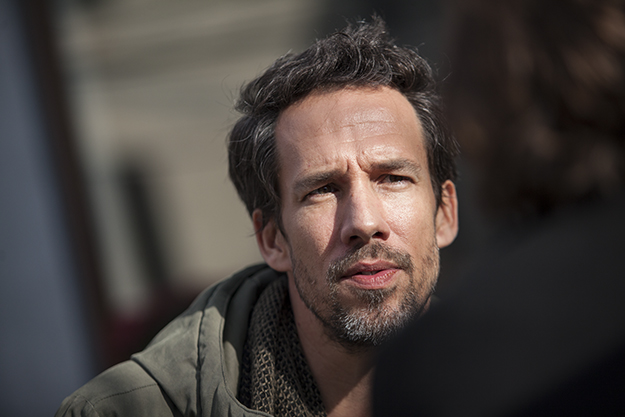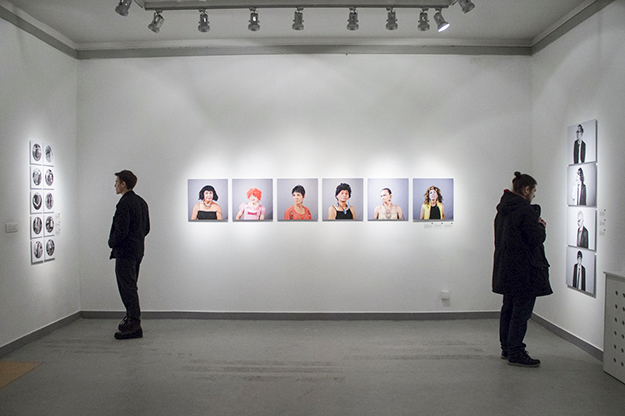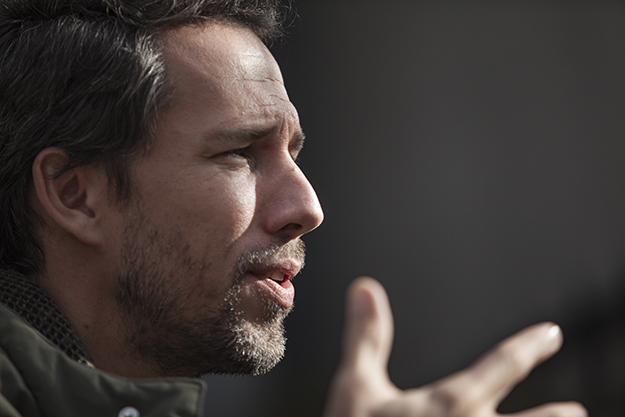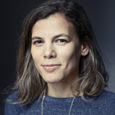At the Faculty of Arts in Prishtina, some new and unfamiliar faces have been giving life to the walls of the gallery since last Tuesday, Nov. 21, as the space opened its doors to the International Pride Photo Award exhibition, which is visiting Prishtina for the first time.
The faces belong to individuals from all over the world, who experience under their skin gender and sexual identities that do not fit into the dichotomy of sexes and genders our societies have been put through since forever. They are beyond.
The exhibition of 60 photographs is the result of the Pride Photo Award photo contest, an international photography competition born seven years ago in Amsterdam. It captures and explores gender identities and sexual diversity through photography, a tool that has the power to stop our eyes from scrolling down, or can hook them into doing so.
The images that are part of this exhibition are part of a visual landscape and tell stories that we are rarely exposed to — they come from far away countries, such as Ukraine, Mexico, Lebanon, or Japan, and perhaps, also far away realities such as intersexuality.
The Pride Photo Award arrives to Kosovo’s capital with the support of the Embassy of the Netherlands in Kosovo, and is organized by Kosovo 2.0 and the Center for Equality and Liberty. It arrives only a few weeks after the country’s first public Pride Parade, which was attended by hundreds; as well as in a year of important legislative changes, such as the acceptance of gender identity as a grounds to penalize discrimination, as part of the Anti-Discrimination Law.
An international jury, formed by names such as Ayperi Karabuda Ecer, former Magnum Photos editor-in-chief, and Hideko Kataoka, director of Photography at Newsweek Japan, are responsible for the final selection of the exhibition. It is remarkable not only for the topics it deals with, but also for the quality and diversity of photography perspectives and formats present in it. The exhibition features a range of photographs, from intimate documentary series, to experimentation with archival images, passing through a variety of full color and black and white documentary and portrait photography.
Erik de Kruijf, project manager and curator of the Pride Photo Award, was in Prishtina last week for the opening of the exhibition, which will be open to the public everyday from 11:00 to 19:00 until Nov. 30. K2.0 spoke to de Kruijf, who also has extensive experience in photo exhibitions as part of the World Press Photo team, about the Pride Photo Award and the content of the exhibition.

Photo: Majlinda Hoxha / K2.0.
K2.0: What was the initial idea of creating an international competition around the issue of gender identity and sexual diversity?
Erik De Kruijf: It came from the city of Amsterdam. A group of people felt that there was a need to get the debate going on the position of sexual and gender minorities, and they were looking for a way to do that. Since World Press Photo is based in Amsterdam, they came up with the idea to model an international photo contest, a little bit like the idea of World Press Photo. From the beginning it’s been an international contest for photography on these specific topics, and out of the winning photos, there was an exhibition.
Until this year, the exhibition was only showcased in Amsterdam. But this year, for the first time, it is traveling around. It has been to Amsterdam, Jakarta, Hanoi, San Francisco and now it’s in this region — in Tirana, Prishtina and Skopje. So it’s quite new for us as well, to send this around the world.
The idea behind it is that we believe photography is one of the best means of communication, one of the most accessible art forms, maybe, to bring the subject to the table. That is what Pride Photo Award is about: it is not about shoving opinions down people’s throats, it is not saying what is wrong and what is right; it’s not about offending people, it’s not about pleasing people, it’s about showing a reality.
These are real people, these are real lives, this is the reality for people and we cannot just try not to see, try not to hear.
This is an everyday reality for LGBT people, for sexual and gender minorities. Through photography you can show people that it’s actually not that scary or strange, it’s just a minority — just like we have ethnic or religious minorities. It is important that people realize that, that there is nothing to be scared about. Too often people are ignorant, scared and prejudiced when it comes to sexuality and gender, and there is no need for it.
In some countries they tend to say that homosexuality, for example, is a product of the West, and I think this exhibition also shows that homosexuality or gender issues, is not something that only happens in the West — it’s from everywhere. You will see stories from all over the world, all corners of the world — that it’s something that has been everywhere, always, and that it has always been quite controversial.
Our understanding and education, the information we receive about sexual diversity, is slowly growing with time. Initiatives like these bring us other realities and it’s gradually less surprising to hear or maybe even talk about them. In the context of the Pride Photo Award, how have the photographers’ perspectives evolved toward the subject? Have you seen a change in the ways photographers have approached sexual and gender identities?
We have already done six contests, and perhaps it is difficult to make a clear observation whether things are changing in that regard yet. What perhaps I could say safely is that there is much more attention to the subject and quite a lot of work done around LGBTI and gender related issues, especially regarding gender issues.
These are themes that were hardly spoken about a few years ago, and now they have become a serious topic and also a photogenic topic. Apart from the mission of telling those stories, it’s also quite a photogenic issue, it’s a more popular subject.
More accepted too?
Definitely in certain circles it is more acceptable. We shouldn’t shy away from potentially controversial subjects. Too often we’re taking the easy road; we think some people may be a little bit offended so let’s not [talk about it]. But these are real people, these are real lives, this is the reality for people and we cannot just try not to see, try not to hear. We have to deal with it. That’s what Pride Photo is doing.

Photo: Agan Kosumi / K2.0.
At the exhibition opening, you said to the public that they may find images that perhaps to some may be uncomfortable, because we don’t understand them, or don’t accept the reality they portray. The exhibition has been in places like Hanoi, Jakarta, Bologna, San Francisco. How has it been received in all these different countries?
In the beginning, I was a little bit afraid — for example, when they contacted us to show it in Jakarta, because Indonesia is really not [one] of the most open countries when it comes to these themes. But we did it, and it was very well received.
I think that is important to keep in mind that exhibitions like these may be a bit challenging for people who are not open to the subject yet, but if we [at least] attract people who are open and are willing to learn from this, or people who recognize the subject, people who may have questions about their gender or their identity themselves… those people will come, and maybe this is also where it starts.
This can also be a grassroots movement, it can trickle down into society. I think we should also be careful with thinking that this will change opinions overnight — it’s not going to happen, but it’s little steps like these that help.
I was in San Francisco for this exhibition, and San Francisco has the reputation of being one of the most open cities in the world. But even there, the subject can be a bit delicate. It’s still America, and there are a lot of states in America that have issues with it. A lot of people have actually died, LGBT youth that moved to San Francisco, and they have a lot of negative luggage as well, negative or hesitant attitudes toward the subject.
If you want to be accepted as an ethnic minority, if you want to be accepted as a person with a different skin tone, then it’s only logical that you will also accept someone from a sexual minority.
It’s not something that happens only in Islamic [conservative] countries, or in Eastern Europe. It’s something that happens everywhere, even in San Francisco, even in Amsterdam. It is still a delicate subject, unfortunately, but true. My experience so far is that it doesn’t really matter where you show it, the reactions are more or less the same.
For people that are willing to open up to it, they will. This is basically a human right, to accept people who are different, and I keep stressing this. It’s a minority, like there are so many minorities. So if you want to be accepted as an ethnic minority, if you want to be accepted as a person with a different skin tone, then it’s only logical that you will also accept someone from a sexual minority. That is something that doesn’t happen often enough.
Lately, there are people who claim to want to be accepted as an ethnic minority, but at the same time they don’t want to accept gay people. It doesn’t work like that. I hope people realize that it’s the same thing. There is no difference when it comes to accepting.
This is an award that is specifically about sexual and gender diversity. You also have a lot of experience with the exhibitions of World Press Photo, where you worked for 10 years and which has become a referent of the must-see photography around the world — must-see photography that usually appears in the press that we consume daily and is part of our imagery, of our culture. Would these kind of photographs, which are part of the Pride Photo Award, have a place in such a larger, also more mainstream, at least in terms of reach, contest like the World Press Photo Award?
In World Press Photo, almost every year in the selection, there is one or two winning photographs or stories dealing with LGBT related issues. So yes, you can really see that with the jury of World Press Photo, which is also a very international one, this is treated like a human right. It’s considered a serious issue. Let’s not forget that people around the world are beaten, are abused, they are being violated.

Photo: Agan Kosumi / K2.0.
Sometimes people underestimate the importance of the subject. In a big contest like World Press Photo, dealing with major issues, on all levels — environmental, political, any big issues — LGBT or gender related issues are more and more represented, because it is also more and more accepted as a basic human right. And that is very good.
Unfortunately, at this point the world is moving in two directions. Some countries are closing up and going backwards when it comes to LGBT rights — Turkey may be a good example; eastern European countries aren’t moving in the best directions when it comes to this. Sometimes LGBT rights are used as a political tool because they are seen as Western, and if you don’t want to associate with Western world you can’t be [supportive of them]. That’s a bit sad. But it’s also part of the process. Change always takes a lot of pain.
We tend to receive many negative stories regarding LGBT rights, but in the exhibition we can also see individuals who enjoy their identities in conservative societies where we might think their rights wouldn’t be always respected, or even accepted. In some cases, for example, a series from Mexico, an elder transgender woman is a social elite who also converts to Christianity in her old age. Can you tell us more insightfully about the stories behind the works?
This is a woman, for example, who converted to the Catholic faith, she got baptized in her 80s, and she is also a very outspoken LGBT rights activist. She is a transgender woman herself, and I think it’s important to see because a lot of religions seem to be very hesitant to open up to these subjects.
They seem to claim, and I am talking specifically about the institutions, like the Church itself, but every faith has it, they claim a certain truth, a truth that is not very favorable to LGBT people. And if a transgender woman who is in favor of equal rights says, “I’m catholic too,” for a lot of people that’s an impossible combination. But who are we to judge that?
That story proves that it is perfectly possibly to be transgender, an LGBT activist, and a devout Catholic. One doesn’t exclude the other, and it’s very important that we realize that, and that we stop becoming too judgmental and that we stop claiming an absolute truth.

Photo: Majlinda Hoxha / K2.0.
The exhibition has already been in Tirana, and it’s going to Skopje after Prishtina. Can you tell our readers more about this ‘Balkan’ visit? How was it received in Tirana and in Prishtina, and what do you expect for the next showcase in Skopje?
Lots of things are happening here, it’s a visit during transition, very much. There are a lot of political changes over the years, a lot of religions represented in the region, so there are a lot of different forces playing a very important role. I also feel there is a big mix of ideas and emotions when it comes to gender and sexuality related topics — some of them negative, some of them completely favorable, and most of them in between.
What I saw in Tirana, for example, is that there has also been a lot of positive energy toward the subject. As I mentioned before, it’s naive to think that everyone will be pro-equal rights, and so on, but I do think there is more openness than we tend to think, also in this region. It’s just that we are not confronted with the subject enough. It’s very easy to have an opinion on something if we don’t know an LGBT person for example, if you don’t know anyone who faces a problem with their sexual or gender identity. It may take time to change people’s opinion but I think this is a good step in the right direction. K
Feature image: Majlinda Hoxha/K2.0.





